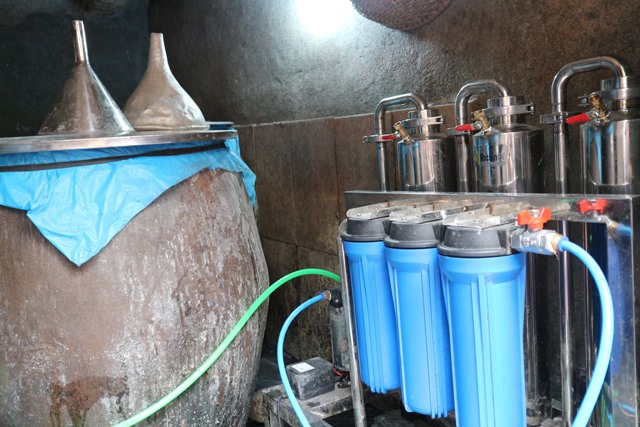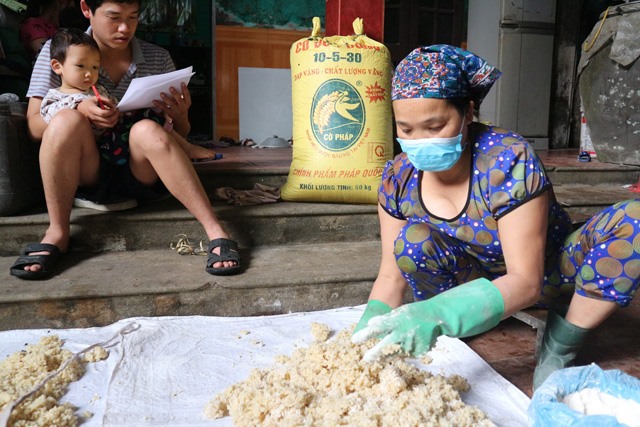 Society
Society

A soaring number of methanol poisoning cases from bad-quality methanol-laced alcohol have substantially harmed the reputation of traditional alcohol-making villages, the Nông Thôn Ngày Nay (Countryside Today) newspaper reported.
 |
| Alcohol-purifying machines in Vân village of Bắc Giang Province. Photo danviet.vn |
HÀ NỘI — A soaring number of methanol poisoning cases from bad-quality methanol-laced alcohol have substantially harmed the reputation of traditional alcohol-making villages, the Nông Thôn Ngày Nay (Countryside Today) newspaper reported.
Nguyễn Thị Hương from Đại Lâm hamlet, a well-known alcohol-making village in Yên Phong District in the northern province of Bắc Ninh, learned the technique from her parents’ generation and has been using the traditional alcohol-making method for years.
But one day two women who introduced themselves as reporters came to her house and later reported on TV that her family was making methanol-laced alcohol, which distorted the fact. Since then, customers no longer buy alcohol at her house.
“The pipes that supply water to clean pigsties were mistakenly reported as being used to provide water for mixing with alcohol and methanol,” Hương said. “My family has preserved the traditional alcohol making method by fermenting herbal powder and medicine. It takes over 10 days to brew herbs and obtain the final product,” Hương’s son Nguyễn Văn Hải said.
“These are the cookers to make alcohol, but the media reported that my family does not have any,” said Nguyễn Thị Đồng, Hải’s wife.
Đỗ Danh Thơm, deputy chairman of the Vân village alcohol production and consumption association in Việt Yên Commune of Bắc Giang Province, was also saddened by misleading information published about his village’s alcohol making.
He said the village has 400 alcohol-making households that follow traditional methods. The alcohol production and consumption association was established in order to create a local brand, and 70 members had their product brands registered.
Thơm said that the association occasionally conducts training on food safety for households in the hamlet. The Bắc Giang Province Department of Agriculture and Rural Development has subsidised eight alcohol-purifying machines to ensure the safety of the alcohol production process.
However, it is challenging to bring products to the market as they arouse customer suspicions due to falsely reported media information, he said.
 |
| Mixing fermentation agents and rice in the alcohol making process. - Photo danviet.vn |
Nguyễn Văn Tôn, chairman of the Tam Đa Commune’s People’s Committee told Nông Thôn Ngày Nay that the media reports were untrue. Đại Lâm village used to have more than 1,000 alcohol-making households, now it has only 200, which make only a few dozen litres of rice liquor to supply local demand.
To check the information reported in the media, provincial authorities have set up an inter-disciplinary team including market surveillance, food safety, standards and environmental officials to assess alcohol samples in Đại Lâm village. All samples tested negative for methanol, he said.
“It is great when the media raises its voice against fake and methanol alcohol. But we need objective and evidence-based information,” he said.
False reports affect the prestige of both the manufacturers and the locality. Local authorities will ask for the information to be corrected, he said. — VNS
As many as 70 to 80 per cent of the alcohol sold in Việt Nam does not have a clear ceritifcate of origin, Đinh Đăng Hiếu of the Environment Police Department said last week at a conference seeking solutions to address methanol-laced alcohol. According to a study by the Institute for Preventive Medicine and Public Health, ten methanol-made alcohol samples taken at households show the liquor is within permitted levels. Experts agreed that methanol poisoning is not caused by homemade alcohol, but rather by using methanol on purpose and on a large scale. Phan Thị Kim, head of the Việt Nam Association of Food Science and Technology, said legal regulations must be formulated for managing alcohol production and business. There has not been any regulation related to alcohol mixing and traditional alcohol, he said. Associate Professor Nguyễn Duy Thịnh from the School of Biotechnology and Food Technology said recent acute alcohol poisoning cases are only part of the story. Hundreds of other people might be exposed to chronic poisoning, the long-term consequences of which have not been fully assessed. Since the beginning of this year, 80,000 litres of alcohol without clear origin were seized in Hà Nội, according to Hà Nội’s Market Surveillance Agency. In some cases, methanol levels found in homemade liquor were up to 1,000 times higher than permitted. |